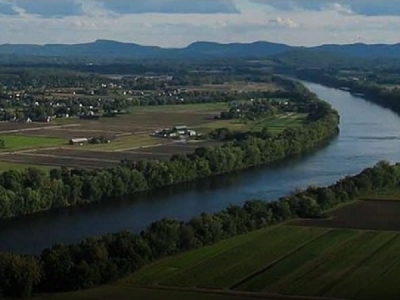
Posted on January 19, 2019
CONCORD, Mass. – The U.S. Army Corps of Engineers, New England District is proposing to perform a riverbank protection project to stabilize approximately 500 linear feet of riverbank along the Connecticut River in Lyme, New Hampshire. The town of Lyme is the local sponsor for the proposed project.
Erosion is occurring at a section of river bank along the western side of River Road, just south of North Thetford Road in Lyme, where the bank is being undermined. The erosion is threatening the integrity of adjacent sections of River Road that immediately abut the riverbank and will ultimately threaten the utilities and residential properties adjacent to the roadway. The town estimates that the active erosion experienced is at a rate of 2 feet per year. If left unchecked, the continued long-term erosion of the riverbank will continue to endanger the roadbed and associated utilities to where they could collapse into the river limiting access to and use of the residential properties located along the eastern side of the road.
The proposed action consists of placing a stone revetment along a 500-linear-foot section of eroding Connecticut River bank located south of North Thetford Road, and running parallel to River Road. The stone revetment was considered to be the most practical solution to alleviate the erosion problems affecting the area. The stone revetment alternative will armor the slope and toe of the riverbank, while allowing the river itself to remain largely undisturbed. Above the revetment, all trees and shrubs will be cleared due to the narrowness of the roadway shoulder before the steep slope down to the river. Access will be required all along the shoulder for the placement of stone.
The proposed project is to provide streambank protection for this area and is being conducted under Section 14 of the Flood Control Act of 1946, as amended. Section 14 provides for the Corps of Engineers to participate in the planning and construction of economically justified stream/river-bank erosion control projects in situations where public facilities are threatened.
To construct the revetment, approximately 5,100 cubic yards of interlocking, 18-inch riprap stone will be placed along the 500-linear foot segment of eroding bank. The initial phase will involve the excavation of the eroding bank to create a constant slope, as well as to establish a stable foundation for the riprap slope. The bedding material will be composed of an initial 1-foot layer of sand followed by another 1-foot layer of gravel before the larger stone is placed. The interlocking riprap will extend between 20-60 feet up the embankment and towards River Road. Excavated topsoil will be retained and placed at the top of the bank for re-use. Once the revetment is complete, native shrubs and a grass seedmix will be planted as cover to reduce erosion and to stabilize the upper bank. No trees will be allowed to grow within or near the engineered slope as their rootballs are capable of destabilizing the revetment, which would ultimately lead to its failure over time.
Waterward of the river’s ordinary high water mark, the riprap will extend 2-5 feet beneath the water’s surface leading to a permanent discharge of fill material over approximately 2,600 square feet. Subsequently, this will change the unconsolidated river bottom habitat to riprap stone. The work will be performed behind a cofferdam, which will reduce potential increased turbidity levels downstream and protect aquatic habitat. The temporary cofferdam will encompass 100-foot segments of the work area to allow for work “in the dry” and advance downstream as the work progresses and be removed upon its completion. To enhance the quality of in-stream fish habitat along the revetment, artificial undercuts, or bendway weirs, may be constructed along the toe of the riverbank to provide habitat features. Appropriate erosion control measures such as silt fences, silt socks, or straw wattles will be used throughout construction.
The proposed work is being coordinated with: U.S. Environmental Protection Agency; U.S. Fish and Wildlife Service; National Marine Fisheries Service: Protected Resources Division and Habitat Conservation Office; New Hampshire Department of Fish and Game: Non-Game and Endangered Wildlife Program, and Inland Fisheries Division; New Hampshire Department of Environmental Services: Water Quality Certification Program; New Hampshire State Historic Preservation Office; and the town of Lyme. An Environmental Assessment of the proposed work has been prepared and will be available upon request.
The public notice, with more detailed information, is available for review on the Corps website at: https://www.nae.usace.army.mil/Missions/PublicNotices.aspx.
Source: U.S. Army Corps of Engineers





